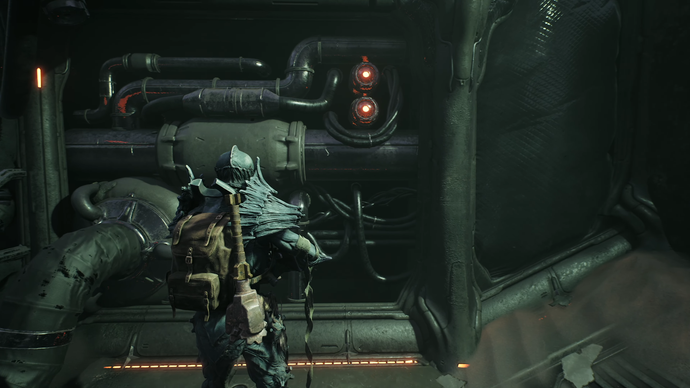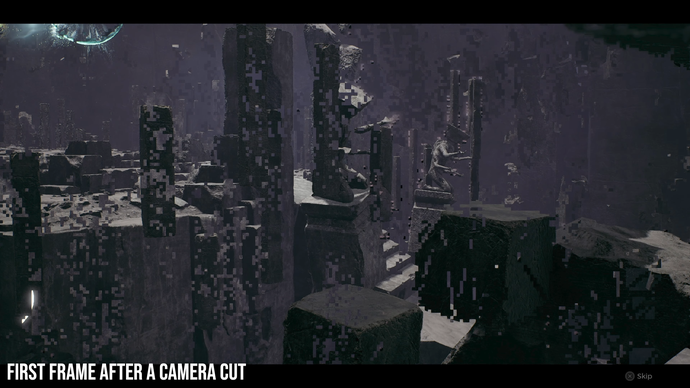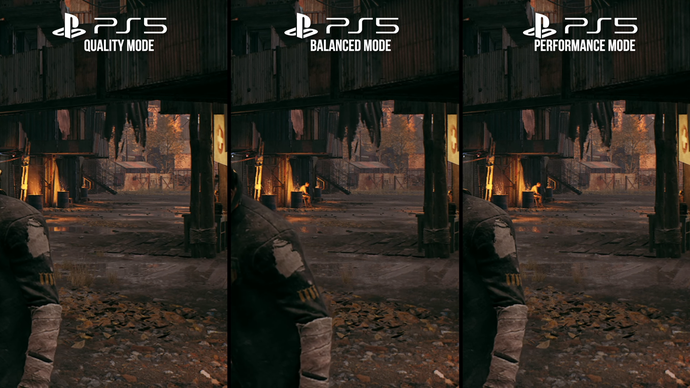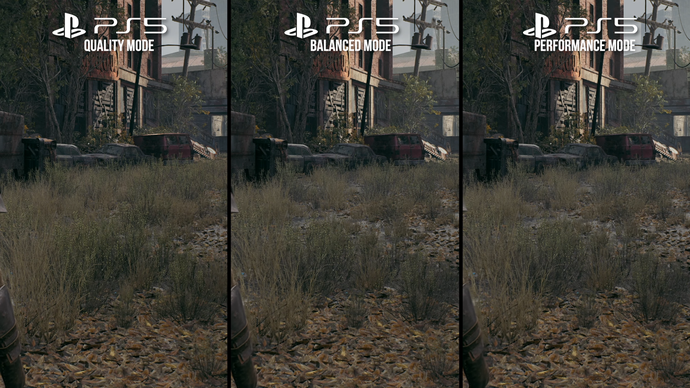Remnant 2 offers an interesting spin on Dark Souls-style action games, combining that series’ fundamental structure with a third-person shooter gameplay and a procedurally generated world. It’s a formula pioneered by the first Remnant game in 2019, but the sequel is more technically interesting – as it’s a current-gen-only title that takes advantage of Unreal Engine 5 features and the enhanced horsepower provided by PS5, Series X and Series S. We’ve tested the game on each of these consoles to discover whether its visuals befit its ninth-gen heritage and whether its procedural systems can deliver a satisfying adventure.
Remnant 2 certainly makes a great first impression. The game’s tutorial area offers a brief glimpse of a Last of Us-style post-apocalyptic city, which offers some satisfying visuals, with excellent artwork, detailed assets and advanced lighting creating a compelling and lived-in environment. However, locales beyond the tutorial area are more mixed, with some – like the dark 20th-century city of Losomn – exhibiting a noticeably less lavish look and relatively basic indirect lighting. These kinds of dusky environments is often hard to light convincingly, and that’s certainly true here.
This is perhaps due to the lack of some key Unreal Engine 5 features, such as Lumen real-time global illumination or any ray tracing effects. Instead, the primary UE5 tech is the Nanite virtualised geometry system, which manifests in a distinct lack of LOD pop-in and an excellent level of up-close geometric detail. Virtual shadow maps also appear to make the cut and while shadows are uniformly sharp, there is no visible shadow cascade whatsoever – so no cut-off point where higher resolution shadows give way to lower resolution versions further from the camera.
Another factor is that the game’s locations seem to be composed of a series of prefabricated environmental blocks integrated through a procedural generation system. Key areas in each location appear to be the same through multiple playthroughs, but the sections in-between shift for each character you create. Some of these blocks can look quite appealing, from glossy and ornate faerie interiors to more science-fiction themed environments. Interior areas in general seem to fare particularly well, with high-fidelity models and materials. When you get up close to any given asset you can really appreciate how fine-grained the detail can be. Other environmental blocks, like the exteriors of Losomn, prove somewhat less compelling.
To some extent, your mileage will vary with the way the game is presented because of its extensive procedural systems. I booted up the game on a new character, after I had played for about a dozen hours on my first, and encountered a totally different first world with different plot elements as well. On another new character, I started on Losomn again, but this time in a different area with a very different layout to my first run on PS5.
This kind of replayability is welcomed – especially for DF reviewers – but they do make the game feel a bit less cohesive than other action titles. You don’t really feel a strong sense of progression as you work your way through each zone, and there aren’t strong visual signposts to help you keep track of your progress. You’ll be finding your way through the game by consulting the in-game map for the most part, which helpfully fills in as you tackle each level.


There’s nothing here that looks wildly ambitious, but each environment comes packed with geometric detail in a way that we didn’t see in last-generation efforts – including the original Remnant from 2019, which features more restrained environments and a flatter look than its sequel. It’s hard to imagine this level of visual improvement without targeting more powerful 9th-generation consoles as a baseline.
Remnant 2 does have a couple of smaller issues though. The game makes heavy use of screen-space effects, with very obvious occlusion issues when the information needed for SSR and screen-space shadows is removed from view. This is hardly unique to Remnant, but the game relies on these techniques more than most so it can be a bit distracting at times. The game’s cutscenes are also pared-back in scope compared to other games, and lack lifelike characters, detailed facial animation, or choreographed action scenes – a consequence of its smaller production values than a contemporary AAA game. The cutscenes have some odd issues at times too, like very low-resolution self-shadows in one scene, and bizarre graphical artefacts right after a camera cut on PS5.
Broadly speaking though, Remnant 2 is an attractive game. The environmental art is impressively high-quality and is realised using generous Nanite-powered polygonal detail. Lighting is good, enemies are visually interesting and respond convincingly to gunfire and melee attacks, and player animations feel responsive. The game’s motion blur also has a pleasingly long shutter speed, even when playing at 60fps. Remnant 2 perhaps isn’t making the most of Unreal Engine 5, but it’s a visually polished game that holds up well among the small cohort of current-gen only titles.


Remnant 2 ships with three modes on PS5 and Series X: a 30fps quality mode, a 60fps balanced mode and an unlocked performance mode. Unlike most contemporary games though, these modes mostly differ in graphical features rather than in perceived resolution.
The quality mode has substantially denser foliage than the other two mode options, while screen space reflections are more detailed and coherent, even at a distance. Shadows are higher resolution, with less breakup and artefacting. It seems like there are a range of little tweaks here and there, probably corresponding to one Unreal Engine preset level higher. Meanwhile, the balanced and performance modes look just about identical in still shots, but performance mode runs with obvious full-screen tearing when the camera moves.
Counting a comprehensive range of rendering resolutions is tough as motion blur is permanently enabled and cutscenes often feature depth-of-field. Based on a limited range of samples though, quality mode on PS5 and Series X is ~1296p, balanced goes down to ~792p and performance mode is ~720p. Dynamic resolution does appear to be in play here in the quality and balanced modes, with the performance mode sticking to that 720p figure. The balanced and performance modes also appear to use upscaling to roughly 1440p, and given the lack of FSR 2 artefacts I suspect Unreal’s Temporal Super Resolution is being used here.


That means a fair bit of image breakup in those higher frame-rate mode options in typical play, though it wasn’t too bad in my experience sitting some distance from a large television, and the motion blur helps to hide a lot of the artefacting. In stills, all the modes look just about identical in image quality, though in motion the quality mode delivers a more stable image.
Series S looks a lot like the other two consoles, but has only one 30fps mode which has similar settings to balanced mode on Series X and PS5 but without motion blur. Series S is rendering at ~900p internally and getting upscaled to 1080p, so the final resolve is substantially less detailed – while the lack of motion blur and 30fps presentation makes the game a bit choppy.
In terms of performance, on PS5’s balanced mode we’re often beneath the 60fps target, with dips all the way to the 30s possible in certain environments and in cutscenes. The 30fps quality mode hits its frame-rate target more reliably, with only occasional single frame drops for the vast run of play. Performance mode adds screen tearing but doesn’t play noticeably better than balanced mode, making it one to avoid. Co-operative play may drop frame-rates further, but I didn’t have a time to test this thoroughly – and most of the performance swings do seem linked to the environments rather than the onscreen action, so this might fare better than expected.
Series X is basically identical to PS5 in terms of performance, dropping frames in the same places, and generally turning in good performance despite some substantial dips. However, there is one curious difference – namely that Series X allows the game to run in a proper 120Hz container, allowing for higher frame-rates than 60fps, something that PS5 does not do. Of course, the game still suffers from intrusive screen-tearing on both consoles in performance mode regardless of refresh rate. Weirdly, VRR didn’t prevent this screen tearing in my testing, even though my TV reported VRR was engaged.
Finally, Series S hits its 30fps target the majority of the time, but it does suffer from steeper versions of the same drops we see in other consoles’ quality modes – plus that choppy appearance we can attribute to the lack of motion blur.

While Remnant 2 definitely has its technical flaws, as one of the first Unreal Engine 5 games around it proves the capability of UE5’s Nanite tech with a level of visual complexity that outstrips last-gen software. Whether you like or dislike the reliance on procedural systems, it’s hard to deny that every hand-crafted piece of Remnant 2’s environments comes packed with polygonal detail and looks quite pleasing in game.
That complexity does come at a cost, with lower-than-usual internal resolutions being only redeemed by reconstruction techniques albeit still with some image breakup in motion. Remnant 2 also struggles to deliver stable performance, with frame-rate dips on all consoles and modes. It’s definitely a compelling current-generation effort, but it does seem rather heavy at times.
That said, I came away impressed with Remnant 2, and if the developers can patch out some of the game’s frame-rate issues it will be a very compelling technical effort. This is an attractive, technology-pushing current-gen-only title, which is a rare sight so far this generation.
- SEO Powered Content & PR Distribution. Get Amplified Today.
- PlatoData.Network Vertical Generative Ai. Empower Yourself. Access Here.
- PlatoAiStream. Web3 Intelligence. Knowledge Amplified. Access Here.
- PlatoESG. Automotive / EVs, Carbon, CleanTech, Energy, Environment, Solar, Waste Management. Access Here.
- BlockOffsets. Modernizing Environmental Offset Ownership. Access Here.
- Source: https://www.eurogamer.net/digitalfoundry-2023-remnant-2-is-a-fitting-showcase-for-unreal-engine-5-nanite-and-a-current-gen-focus
- 2019
- a
- AAA
- About
- accompany
- Action
- adds
- advanced
- ADvantage
- Adventure
- after
- again
- All
- Allowing
- allows
- also
- ambitious
- among
- an
- and
- Animation
- animations
- Another
- any
- appreciate
- ARE
- AREA
- areas
- around
- Art
- artwork
- as
- asset
- Assets
- At
- attractive
- attribute
- avoid
- away
- bad
- based
- Baseline
- BE
- because
- being
- Better
- beyond
- Bit
- blocks
- both
- but
- by
- came
- CAN
- capability
- certain
- certainly
- character
- characters
- City
- close
- cohesive
- Cohort
- combining
- come
- comes
- compared
- compelling
- complexity
- comprehensive
- Consoles
- consulting
- Container
- contemporary
- corresponding
- cost
- Couple
- course
- coverage
- create
- Creating
- Curious
- Cut
- Dark
- definitely
- deliver
- demonstrates
- despite
- detail
- detailed
- developers
- differ
- difference
- different
- discover
- distance
- Distant
- distinct
- do
- does
- doesn
- don
- down
- dozen
- Drop
- dropping
- drops
- due
- dynamic
- each
- effects
- effort
- efforts
- EG
- elements
- enabled
- engaged
- engine
- enhanced
- Environment
- environmental
- environments
- especially
- even
- Every
- Exhibiting
- expected
- experience
- extensive
- factor
- fair
- far
- Feature
- Features
- feel
- Figure
- Final
- finding
- First
- First Impression
- flaws
- For
- formula
- Frame
- from
- fundamental
- further
- game
- gameplay
- Games
- General
- generally
- generated
- generation.
- generous
- geometry
- Get
- getting
- give
- given
- glimpse
- Global
- goes
- good
- great
- Group
- had
- Hard
- has
- Have
- heavy
- help
- helps
- here
- heritage
- Hide
- High-Quality
- higher
- hits
- holds
- hours
- How
- however
- HTTPS
- i
- identical
- if
- image
- imagine
- impressed
- improvement
- in
- in-game
- Including
- information
- instead
- integrated
- interesting
- internal
- internally
- intrusive
- Is
- isn
- issues
- IT
- ITS
- just
- keep
- Key
- Key Areas
- kind
- lack
- large
- last
- Lavish
- layout
- less
- Level
- light
- Lighting
- like
- Limited
- linked
- Little
- ll
- location
- locations
- Long
- Look
- looks
- lot
- Lumen
- major
- Majority
- make
- MAKES
- Making
- map
- Maps
- materials
- May
- means
- Meanwhile
- Melee
- might
- minor
- mixed
- mode
- models
- modes
- more
- most
- mostly
- multiple
- my
- namely
- Nanite
- needed
- New
- no
- not
- nothing
- obvious.
- Odd
- of
- Offers
- often
- on
- One
- only
- Options
- or
- original
- Other
- our
- out
- Packed
- part
- particularly
- Patch
- PC
- perceived
- performance
- perhaps
- permanently
- piece
- pioneered
- places
- plato
- plato data intelligence
- platodata
- platogaming
- play
- played
- player
- Playing
- Plenty
- Plus
- Point
- possible
- powerful
- presentation
- presented
- prevent
- primary
- probably
- produces
- Production
- Progress
- progression
- proper
- prove
- proves
- provided
- ps5
- quality
- quite
- range
- Rare
- rate
- rather
- ray
- RE
- real-time
- really
- Reflections
- regardless
- relatively
- reliance
- removed
- rendering
- reported
- resolution
- Resolve
- responsive
- right
- roughly
- Run
- runs
- s
- Said
- same
- satisfying
- scene
- scenes
- scope
- Screen
- see
- seem
- seems
- sense
- sequel
- Series
- settings
- Shadow
- shift
- ships
- Shooter
- Showcase
- sight
- similar
- single
- Sitting
- small
- smaller
- So
- so Far
- Software
- some
- something
- Space
- Speaking
- speed
- Spin
- stable
- started
- sticking
- still
- strong
- structure
- substantial
- substantially
- such
- super
- system
- Systems
- tackle
- takes
- Target
- targeting
- tech
- Technical
- technically
- techniques
- Technology
- television
- terms
- test
- tested
- Testing
- than
- that
- The
- The Game
- Themed
- there
- These
- they
- this
- those
- though
- three
- Through
- time
- times
- Title
- titles
- to
- too
- totally
- tough
- Tracing
- track
- true
- turning
- tutorial
- tv
- two
- typical
- ue5
- unique
- unlike
- unlocked
- Unreal
- unreal engine
- Unreal Engine 5
- unusual
- up
- upscaling
- use
- used
- using
- values
- vast
- ve
- versions
- very
- Video
- View
- Virtual
- visuals
- was
- wasn
- way
- we
- welcomed
- well
- when
- where
- whether
- while
- will
- with
- without
- Work
- world
- X
- you
- your
- youtube
- zephyrnet











